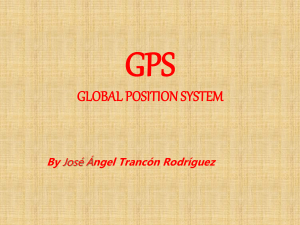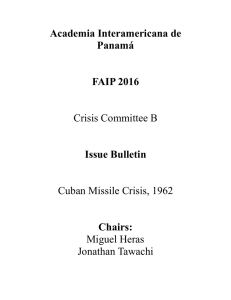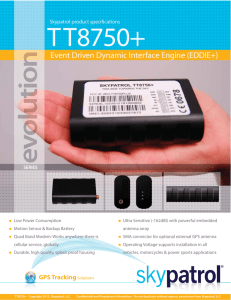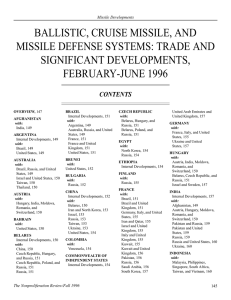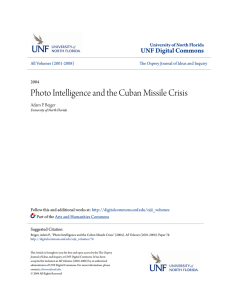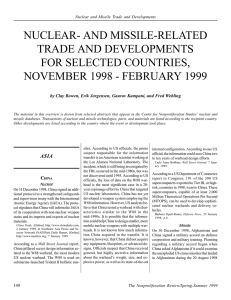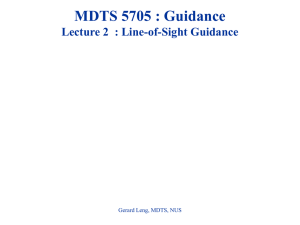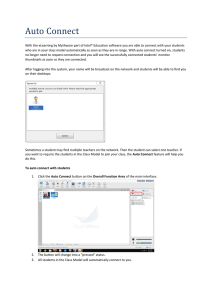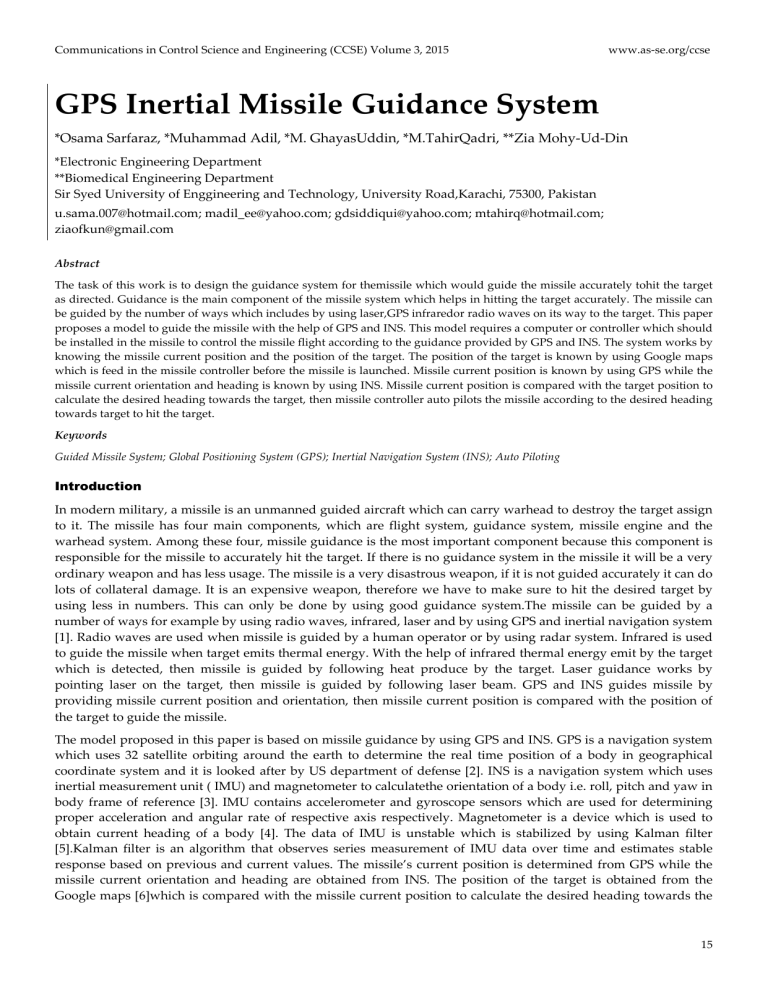
Communications in Control Science and Engineering (CCSE) Volume 3, 2015 www.as-se.org/ccse GPS Inertial Missile Guidance System *Osama Sarfaraz, *Muhammad Adil, *M. GhayasUddin, *M.TahirQadri, **Zia Mohy-Ud-Din *Electronic Engineering Department **Biomedical Engineering Department Sir Syed University of Enggineering and Technology, University Road,Karachi, 75300, Pakistan [email protected]; [email protected]; [email protected]; [email protected]; [email protected] Abstract The task of this work is to design the guidance system for themissile which would guide the missile accurately tohit the target as directed. Guidance is the main component of the missile system which helps in hitting the target accurately. The missile can be guided by the number of ways which includes by using laser,GPS infraredor radio waves on its way to the target. This paper proposes a model to guide the missile with the help of GPS and INS. This model requires a computer or controller which should be installed in the missile to control the missile flight according to the guidance provided by GPS and INS. The system works by knowing the missile current position and the position of the target. The position of the target is known by using Google maps which is feed in the missile controller before the missile is launched. Missile current position is known by using GPS while the missile current orientation and heading is known by using INS. Missile current position is compared with the target position to calculate the desired heading towards the target, then missile controller auto pilots the missile according to the desired heading towards target to hit the target. Keywords Guided Missile System; Global Positioning System (GPS); Inertial Navigation System (INS); Auto Piloting Introduction In modern military, a missile is an unmanned guided aircraft which can carry warhead to destroy the target assign to it. The missile has four main components, which are flight system, guidance system, missile engine and the warhead system. Among these four, missile guidance is the most important component because this component is responsible for the missile to accurately hit the target. If there is no guidance system in the missile it will be a very ordinary weapon and has less usage. The missile is a very disastrous weapon, if it is not guided accurately it can do lots of collateral damage. It is an expensive weapon, therefore we have to make sure to hit the desired target by using less in numbers. This can only be done by using good guidance system.The missile can be guided by a number of ways for example by using radio waves, infrared, laser and by using GPS and inertial navigation system [1]. Radio waves are used when missile is guided by a human operator or by using radar system. Infrared is used to guide the missile when target emits thermal energy. With the help of infrared thermal energy emit by the target which is detected, then missile is guided by following heat produce by the target. Laser guidance works by pointing laser on the target, then missile is guided by following laser beam. GPS and INS guides missile by providing missile current position and orientation, then missile current position is compared with the position of the target to guide the missile. The model proposed in this paper is based on missile guidance by using GPS and INS. GPS is a navigation system which uses 32 satellite orbiting around the earth to determine the real time position of a body in geographical coordinate system and it is looked after by US department of defense [2]. INS is a navigation system which uses inertial measurement unit ( IMU) and magnetometer to calculatethe orientation of a body i.e. roll, pitch and yaw in body frame of reference [3]. IMU contains accelerometer and gyroscope sensors which are used for determining proper acceleration and angular rate of respective axis respectively. Magnetometer is a device which is used to obtain current heading of a body [4]. The data of IMU is unstable which is stabilized by using Kalman filter [5].Kalman filter is an algorithm that observes series measurement of IMU data over time and estimates stable response based on previous and current values. The missile’s current position is determined from GPS while the missile current orientation and heading are obtained from INS. The position of the target is obtained from the Google maps [6]which is compared with the missile current position to calculate the desired heading towards the 15 www.as-se.org/ccse Communications in Control Science and Engineering (CCSE) Volume 3, 2015 target. The missile guidance is done according to the desired heading towards the target by adjusting the missile current heading until it is the same as the desired heading towards the target. The missile roll, pitch and yaw are controlled by using control surfaces i.e. ailerons, elevators and rudders respectively. The missile engine throttling is controlled by using electronic speed controller. When gas engine is used, the servo mechanism is used to control the throttling of the engine by controlling the governor which is responsible for speed controlling of the gas engine where as electrical engine throttling is controlled by using electrical circuits responsible to vary the speed of the electrical engines. The controlled surfaces mechanism is implemented by using servo motor which is attached with controlled surfaces with the help of push rods. For implementing GPS inertial guidance of the missileit requires a computer or controller with heavy processing power to be installed in the missile. The paper is organized as follows: section II explains the system model. Section III discusses the working of the system. Finally section IV concludes the paper followed by the key references used in the work results followed by the key references used in this work. System Model The work is divided into 3 parts. The first part is to select the target using Google maps and get its coordinates. The second part is the missile GPS (Global Positioning System) inertial guidance system. The third part is the auto piloting of the missile by using GPS inertial guidance. The overall block diagram of the proposed system is illustrated below. Target Selection from Google Maps GPS Inertial Guidance of the Missile Auto Piloting FIG.-1 BLOCK DIAGRAM OF THE SYSTEM Target Selection FIG.-2 TARGET SELECTION (TAKEN FROM GOOGLE MAPS [6]) 16 Communications in Control Science and Engineering (CCSE) Volume 3, 2015 www.as-se.org/ccse The first step is to select the target and get its geographical coordinates i.e. latitude and longitude from Google maps [6] as shown in “Fig.-2”. After target selection, the target coordinates is fed into missile controller and missile will be launched. Missile after launching will autonomously fly towards target with the help of GPS Inertial guidance and hit the target. The next section is about GPS Inertial guidancesystem in order to guide the missile towards the target. GPS Inertial Guidance of the Missile The second step is to guide the missile towards the target by using GPS inertial guidance system. The purpose of this process is to get the missile’sreal time current position, orientation and the desired direction towards the target. The current position of the missile with its orientation is calculated with the help of GPS and INS (Inertial Navigation System). In our work, the GPS is used to obtain the current missile position, its speed and other useful information.The working of GPS is illustrated in “Fig.-3”. From Satellite GPS Receiver Module NMEA Message Decoding Position Speed Altitude FIG.-3WORKING OF THE GPS SYSTEM The working of INS is based on 6 degrees of freedom IMU (Inertial Measurement Unit) containing 3 axis of gyroscope and 3 axis of accelerometer. The response of gyroscope is very fast whereas the response of accelerometer is bit slow, so Kalman filter is used to get stable roll and pitch angles of the missile. Three axis magnetometer provides missile current heading, which is also used as yaw[7]. Magnetometer tilt compensation is done using roll and pitch from IMU. The working of INS is illustrated below. IMU Kalman Filtering Roll And Pitch Magnetometer Tilt Compensation Heading And Yaw FIG.-4 WORKING OF THE INERTIAL NAVIGATION SYSTEM In “Fig.-4”, Kalman filter is used to observe series measurement of roll and pitch calculated from accelerometer and gyroscope over time. After observation, Kalman filter estimates stable roll and pitch with fast response based on 17 www.as-se.org/ccse Communications in Control Science and Engineering (CCSE) Volume 3, 2015 the current and the previous roll and pitch calculated from accelerometer and gyroscope. The desired heading towards target (HT) is calculated by using missile current position and target position with the help ofHaversineformula given below. HT =atan2(sin(Δλ).cos(φ2),cos(φ1).sin(φ2)−sin(φ1).cos(φ2).cos(Δλ) ) Eq. (1) Where φ1 and λ1 are the latitudes and longitude of the missile current position, whereas φ2 and λ2 are the latitude and longitude of the target position. All the process is done in missile controller. The next and the last step is auto piloting of the missile using GPS Inertial guidance which is explained in section below. Auto Piloting The last step is the auto piloting of the missileby using GPS Inertial guidance. The missile controller pilots the missile according to the desired heading towards the target, provided by the GPS Inertial guidance mechanism, by controlling missile speed, roll, pitch and yaw. Auto pilot controls missile speed using electronic speed controller and missile roll, pitch and yaw by using control surfaces aileron, elevator and rudder respectively. The working of auto piloting of the missile is illustrated in “Fig.-5”. Desired Heading Auto piloting Speed Controlling Roll, Pitch And Yaw Controlling FIG.-5THE WORKING OF THE AUTO PILOTING SYSTEM The controlled surfaces are connected with servo motors with push rods, so missile controller controls all three controlled surfaces i.e. aileron, elevator and rudder by using servo motors. Operations of all three controlled surfaces are illustrated in “Fig.-6”. FIG.-6 OPERATIONS OF CONTROL SURFACES, TAKEN FROM [8] 18 Communications in Control Science and Engineering (CCSE) Volume 3, 2015 www.as-se.org/ccse The missile controller controls the speed of the missile by using electronic speed controller which controls the throttling of the missile engine. Servo motors and electronic speed controller is controlled by using PWM signals illustrated in “Fig.-7”. PWM width from 1 millisecond to 2 millisecond at 50 hertz frequency controls servo position from 0 to 180 degrees of angle and controls 0 to 100 percent throttling of the missile engine. FIG.-7 PWM SIGNALS OF SERVO AND ELECTRONIC SPEED CONTROLLER Working of the System The research is carried out in order to design a guidance system to guide the missile by using GPS inertial guidance to accurately hit its target. The process starts by selecting a target and then getting its geographicalcoordinates i.e. latitude and longitudefrom Google maps to be fed in the missile controller. After target coordinates is fed, the missile is launched vertically then auto piloting of the missile is started after it reaches to a height at which stable auto piloting can be done. The auto piloting of the missile is done by GPS inertial guidance mechanism. The GPS inertial guidance mechanism works by using GPS and inertial navigation system (INS). With the help of GPS receiver, the missile current position, speed and altitude are known. INS calculates the missile’s current orientation and heading by using 6 degree of freedom inertial measurement unit (IMU) and 3 axis magnetometer. The data of the IMU is filtered by using Kalman filter in order to get stable roll and pitch angles of the missile. The current heading of the missile is known by using 3 axis magnetometer which is tilt compensated by using roll and pitch angles of the missile.The missile’s controlled surfaces are connected with servo motors with push rods, so missile controller controls all three controlled surfaces i.e. aileron, elevator and rudder by using servo motors. The missile controller controls the speed of the missile by using electronic speed controller which controls the throttling of the missile engine.The missile controller uses PWM signals to control the missile orientation and speed. The missile desired heading towards target is calculated by using the missile current position and position of the target. Auto pilot adjusts missile’s current heading according to the desired heading heading towards target by using rudder and it continuously adjusts until the missile current heading is the same as the desired heading towards target. During the adjustment of the missile’s heading, the missile should be horizontally stabilized, so the auto pilot stabilizes the missile by using elevator and ailerons according to the pitch and roll angles respectively. Once the missile reaches the desired the target position, auto pilot changes the missile orientation to vertical by using elevator, in order to hit the target. Conclusion and Future Work This paper discusses a method for a guiding the missile towards its target by using GPS inertial guidance. The advantage of using this technique is that the missile will accurately hit its target which will result in less collateral damage and there will be no need to fire more additional missiles because the desired target can be hit by using few missiles. Once the missile is launched, there will be no need of manual controlling of the missile because the missile controller will controls the missile flight towards the target. 19 www.as-se.org/ccse Communications in Control Science and Engineering (CCSE) Volume 3, 2015 This work can be enhanced further by proposing a system that can track the target when it’s in motion, because the propose model is for the target in rest.The work can also be enhanced by estimating missile current position by using IMU because GPS has signaling issue and update rate is low. REFERENCES [1] Zhurbal, Alexander, and Moshe Idan., "Effect of Estimation on the Performance of an Integrated Missile Guidance and Control System." IEEE Transactions on Aerospace and Electronic Systems, pp. 2690-2708, 2011 [2] Letham, Lawrence. GPS Made Easy-: Using Global Positioning Systems in the Outdoors. Rocky Mountain Books Ltd, 2011. [3] Won, S.H., William W. Melek, and FaridGolnaraghi. "A Kalman/particle filter-based position and orientation estimation method using a position sensor/inertial measurement unit hybrid system." IEEE Transactions on Industrial Electronics, pp. 1787-1798, 2010. [4] Sun, Zheng, et al. "Headio: zero-configured heading acquisition for indoor mobile devices through multimodal context sensing." Proceedings of the 2013 ACM international joint conference on Pervasive and ubiquitous computing, 2013. [5] Li, Guangchun, et al. "The MEMS gyro stabilized platform design based on Kalman Filter." IEEE International Conference on Optoelectronics and Microelectronics (ICOM), 2013. [6] Google earth software, available at www.earch.google.com [7] Chao, HaiYang, YongCan Cao, and YangQuan Chen., "Autopilots for small unmanned aerial vehicles: a survey", International Journal of Control, Automation and Systems, pp. 36-44, 2010. [8] 20 Principles of guided missile, available at: http://www.hnsa.org/doc/missile/part1.htm
